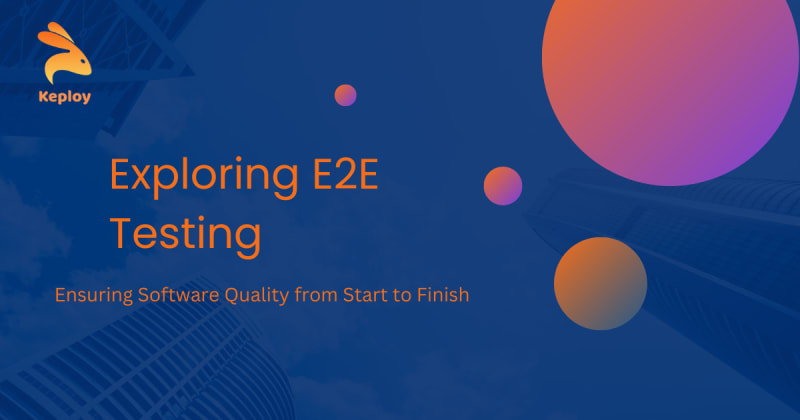
In the dynamic landscape of software development, ensuring the quality of applications is paramount. End-to-End (E2E) testing has emerged as a crucial practice to validate that a software application behaves as expected across its entire workflow. This comprehensive testing approach simulates real user scenarios, allowing developers to identify and rectify issues before they reach end-users. In this article, we'll delve into the fundamentals of e2e testing, its benefits, challenges, and best practices.
What is End-to-End Testing?
End-to-End testing is a software testing methodology that evaluates the functionality of an entire application from start to finish. Unlike unit testing, which focuses on individual components, and integration testing, which verifies interactions between components, E2E testing ensures that all components work together seamlessly. This holistic approach mimics the user's experience and validates the application's behavior across different layers and components.
Key Components of E2E Testing:
- Automation: E2E testing is often automated to simulate real user interactions. Automated testing frameworks, such as Selenium, Cypress, and TestCafe, enable testers to create scripts that mimic user actions like clicking buttons, filling forms, and navigating through the application.
- Scenarios: Test scenarios in E2E testing represent real-world user journeys. These scenarios cover critical paths within the application and help identify potential bottlenecks or issues that users might encounter.
- User Interface (UI) Testing: E2E testing extensively covers UI interactions to ensure that the user interface elements and user experience meet the specified requirements. This includes validating layout, design, and responsiveness across various devices and browsers.
- Data Flow: E2E testing evaluates the flow of data through the entire system. This involves verifying that data is correctly processed, stored, and retrieved across different components and layers of the application.
Benefits of End-to-End Testing:
- Comprehensive Coverage: E2E testing provides a comprehensive examination of the entire application, ensuring that all components work together harmoniously. This helps identify issues that might go unnoticed in unit or integration testing.
- Real User Experience: By simulating real user interactions, E2E testing provides insights into how end-users will experience the application. This helps in detecting issues related to usability, performance, and overall user satisfaction.
- Early Bug Detection: Identifying and fixing bugs early in the development lifecycle is more cost-effective. E2E testing allows teams to catch issues at an early stage, preventing them from escalating and reaching production.
- Increased Confidence in Releases: With thorough E2E testing, development teams gain confidence in the stability and reliability of their applications. This confidence is crucial for frequent and successful software releases.
Challenges in End-to-End Testing:
- Complexity and Time: E2E testing can be time-consuming and complex, especially for large and intricate applications. Creating and maintaining a suite of E2E tests requires a significant investment in time and resources.
- Flakiness: Automated E2E tests can be susceptible to flakiness, where tests produce inconsistent results due to factors such as network latency, third-party dependencies, or changes in the application's UI.
- Maintenance Overhead: As the application evolves, E2E tests may require constant updates to align with changes in the UI, functionality, or underlying architecture. This maintenance overhead can be challenging to manage.
- Cost: Developing and maintaining E2E testing infrastructure, including tools and frameworks, can incur costs. Organizations need to balance the benefits of E2E testing with the associated expenses.
Best Practices for Effective E2E Testing:
- Selective Test Automation: Not all scenarios need to be automated. Focus on automating critical paths and scenarios that have a high impact on the application's functionality.
- Isolation of Test Environments: Ensure that the testing environment is isolated from the production environment to prevent unintended consequences. This includes using separate databases, servers, and configurations.
- Regular Test Maintenance: Keep E2E tests up-to-date with changes in the application. Regularly review and update test scripts to align with the evolving features and UI elements.
- Parallel Execution: To expedite testing, consider parallel execution of test cases. Running tests concurrently can significantly reduce the overall testing time.
- Continuous Integration/Continuous Deployment (CI/CD) Integration: Integrate E2E tests into the CI/CD pipeline to automatically trigger tests with each code change. This ensures that new features are validated and deployed seamlessly.
- Collaboration between Teams: Foster collaboration between development, testing, and operations teams to address issues promptly. This collaborative approach enhances communication and accelerates the resolution of identified problems.
Conclusion:
End-to-End testing is a critical element in the software development lifecycle, ensuring that applications meet user expectations and perform seamlessly across various scenarios. While it comes with its challenges, the benefits of comprehensive test coverage, early bug detection, and increased confidence in releases outweigh the drawbacks. By adopting best practices and leveraging automation tools, development teams can harness the power of E2E testing to deliver high-quality software in an efficient and reliable manner.


















